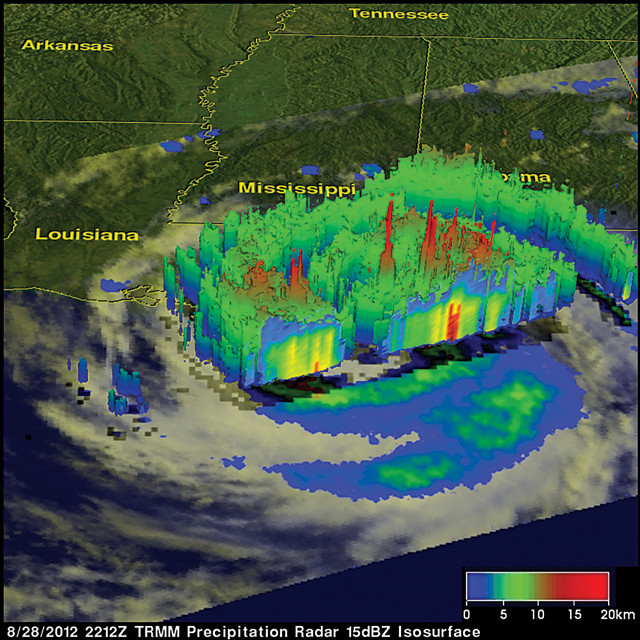
by Mary Caperton Morton Friday, July 17, 2015

Data from the Tropical Rainfall Measuring Mission show Hurricane Isaac dropping heavy rainfall over the Gulf of Mexico. A new study shows that rainfall can reduce a hurricane's intensity on its way to making landfall. Credit: NASA/SSAI, Hal Pierce.
Meteorologists have gotten better and better at forecasting the paths of hurricanes and tropical storms, but predicting how intense a storm will be when it makes landfall has proved more difficult. Now, a new study offers a detailed look at how the energetic contributions of rain — once thought to be a trivial factor in such systems — can dramatically affect storm windspeeds and intensity.
“As raindrops fall through a hurricane, they lose energy due to friction with the air,” says Tapan Sabuwala, a physicist at the Okinawa Institute of Science and Technology in Japan and lead author of the new study, published in Geophysical Research Letters. The rate at which this energy loss happens is called rainpower. “A hurricane generates a colossal amount of rain: An average hurricane can easily dump about half a trillion gallons of water in a day,” Sabuwala says. So rainpower could be “a significant contributor to the overall energetic balance of a hurricane.”
However, rainpower is not always taken into account when modeling hurricanes because it’s not easy to quantify, Sabuwala says. He and his team created thermodynamic hurricane models to predict storm intensity with and without rainpower, including factors such as mean sea-level pressure and sea-surface temperature and drawing upon 15 years of rainfall data from the Tropical Rainfall Measuring Mission satellite, a joint collaboration between NASA and the Japan Aerospace Exploration Agency. They found that rainpower is equivalent to about 15 percent of the power produced by the warm ocean waters that feed tropical storms, and that the energy lost to friction between falling rain and the winds of a hurricane can lessen a storm’s maximum intensity by as much as 30 percent.
“At first glance the results were surprising,” Sabuwala says, because he and his colleagues found that rainpower increased with increasing storm intensity. “From this observation, one might reach the wrong conclusion that, since rainpower and intensity are positively correlated, rainpower increases hurricane intensity,” he says. “However, when we turn the rainpower ‘on’ or ‘off’ [in our models], the results reveal the true influence of rainpower, which is to reduce predicted hurricane intensities.”
This doesn’t mean that storms that produce more rain are necessarily rendered less powerful than storms with less rain, because of the complex nature of storms, Sabuwala says. “More rain is also related to higher rates of ocean-derived fuel for the hurricane, which could make it more powerful. Thus, there are competing effects related to rain that affect how powerful a hurricane can be.”
The new study assigns some interesting numbers to the effects of rainpower on hurricane intensity, but the main observations are not necessarily new, says Frank Marks, a meteorologist at the Hurricane Research Division at NOAA’s Atlantic Oceanographic and Meteorological Laboratory in Miami. “Rainpower is something we’ve known about for some time, and many hurricane models do account for its influence on storms,” Marks says.
However, more work is needed to better understand how rainpower and other factors interact in storm systems, Marks notes. “This group is taking a slightly different approach to quantifying rainpower,” he says. “Their models may prove useful, but it’s also possible they’re oversimplifying.”
Sabuwala says his team’s next step is to incorporate its rainpower models into state-of-the-art computational models that chart the dynamic evolution of hurricanes. The work, he says, “has the potential to bring predictions of hurricane intensity closer to reality, which has implications for disaster management, weather and climate-change forecasting, and policymaking.”
© 2008-2021. All rights reserved. Any copying, redistribution or retransmission of any of the contents of this service without the expressed written permission of the American Geosciences Institute is expressly prohibited. Click here for all copyright requests.